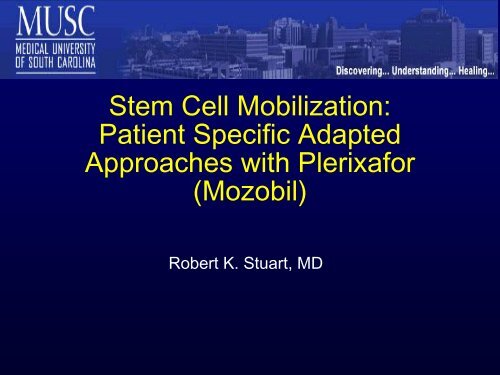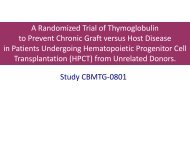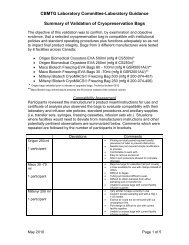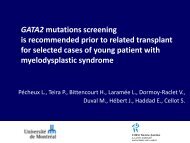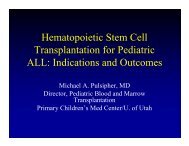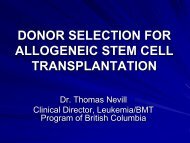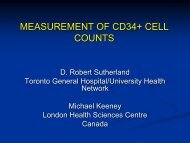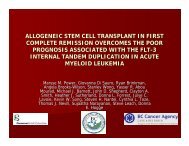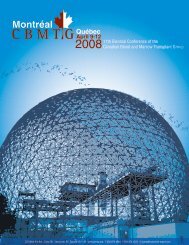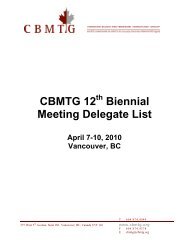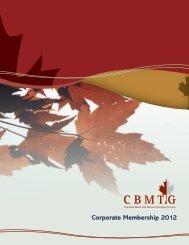Stem Cell Mobilization - CBMTG
Stem Cell Mobilization - CBMTG
Stem Cell Mobilization - CBMTG
Create successful ePaper yourself
Turn your PDF publications into a flip-book with our unique Google optimized e-Paper software.
<strong>Stem</strong> <strong>Cell</strong> <strong>Mobilization</strong>:<br />
Patient Specific Adapted<br />
Approaches with Plerixafor<br />
(Mozobil)<br />
Robert K. Stuart, MD
DISCLOSURES<br />
• This presentation is sponsored by Genzyme Corporation.<br />
– Honorarium Yes<br />
– Employment No<br />
– Stock No<br />
– Stock options No<br />
– Coercion No<br />
– Bribes No
SDF-1 CXCR4 Interaction
Plerixafor Mechanism of Action
Plerixafor<br />
• US FDA approval Dec. 15, 2008<br />
– “for use in combination with G-CSF to mobilize hematopoietic stem<br />
cells to the peripheral blood for collection and subsequent<br />
autologous transplantation in patients with non-Hodgkin lymphoma<br />
(NHL) and multiple myeloma (MM).”<br />
• Study 1:<br />
– 298 patients with NHL: goal 5x10 6 CD34+ cells/kg in < 5 sessions<br />
– Plerixafor + G-CSF: 59% median 3 sessions<br />
– Placebo + G-CSF: 20% n/a<br />
• Study 2:<br />
– 302 patients with MM: goal 6x1010 6 CD34+ cells/kg in < 3 sessions<br />
– Plerixafor + G-CSF: 72% median 1 session<br />
– Placebo + G-CSF: 34% median 4 sessions
Cost Effective Use of Plerixafor<br />
• Maximize likelihood of<br />
successful mobilization<br />
• Minimize total costs of<br />
mobilization
QUESTIONS<br />
• Can plerixafor use be adapted to use it only in patients<br />
who need it for stem cell mobilization?<br />
• Can patients who need G only vs P+G be identified?<br />
• Is patient adapted plerixafor + growth factors (P+G) as<br />
effective as chemotherapy + growth factors (C+G)?<br />
• What is the quality of the stem cell graft mobilized by<br />
P+G vs C+G?<br />
• Does C+G mobilization add antineoplastic value?
Strategy 1 : Plerixafor for <strong>Mobilization</strong> failures<br />
Advantages<br />
Lowest use of plerixafor<br />
(~20%)<br />
Disadvantages<br />
Longer “wait” for transplant<br />
Higher growth factor cost<br />
Higher apheresis cost<br />
Unpredictability<br />
Disruption of “flow” through the<br />
transplant center<br />
8
Strategy 2 : Plerixafor for patients “at risk” for<br />
mobilization failure<br />
Advantages<br />
Intermediate rate of use of<br />
plerixafor (~30-40%)<br />
Reduced need for re-mobilization<br />
Greater predictability<br />
Disadvantages<br />
Models for prediction of<br />
mobilization failure are<br />
imperfect<br />
Does not correct “slow” and<br />
“inadequate” collections<br />
High cost of plerixafor<br />
9
Strategy 3 : Plerixafor decision based on actual<br />
mobilization of CD34+ cells after 4 days of G-CSF<br />
Advantages<br />
Disadvantages<br />
Reduced need for<br />
remobilization<br />
Lower number of apheresis<br />
sessions<br />
High rate of plerixafor utilization<br />
(~40-70%)<br />
Need for stat CD34+ count<br />
Avoid unnecessary use of<br />
plerixafor in patients with<br />
adequate G-CSF mobilization<br />
Lower growth-factor,<br />
apheresis and<br />
cryopreservation costs<br />
Improved transplant center<br />
“flow” (predictability)<br />
10
Decision based on actual mobilization results<br />
– CD34+ enumeration on Day 4 of G-CSF<br />
Intermediate CD34<br />
Cut-off CD34+ count determined by:<br />
-<strong>Mobilization</strong> target<br />
-Cost<br />
•<br />
Extremely low CD34<br />
Destined to fail –<br />
Plerixafor necessary<br />
CD34+<br />
Extremely high CD34<br />
Destined to succeed –<br />
Plerixafor unnecessary<br />
11
Decision based on actual mobilization capacity – What<br />
threshold to use? What about CD34=10/μL?<br />
PB CD34+ /μL<br />
≤ 10<br />
PB CD34+ /μL > 10<br />
Median (range) cumulative CD34+ cells/kg<br />
x 10 6 after 2 apheresis days<br />
Median (range) cumulative CD34+ cells/kg<br />
x 10 6 after 4 apheresis days<br />
0.97 (0.06 - 9.16) 3.30 (0.46 - 12.00)<br />
1.31 (0.06 - 10.58) 4.52 (0.46 - 15.00)<br />
20.4% of patients did not<br />
collect ≥ 2 x 10 6 after 4<br />
aphaeresis sessions<br />
% Patients achieving ≥2 x 10 6 CD34+<br />
<strong>Cell</strong>s/kg in 2 days<br />
22.7 65.3<br />
% Patients achieving ≥2 x 10 6 CD34+<br />
<strong>Cell</strong>s/kg in 4 days<br />
% Patients achieving ≥5 x 10 6 CD34+<br />
<strong>Cell</strong>s/kg in 2 days<br />
34.7 79.6<br />
5.3 30.6<br />
59.2% did not collect the<br />
target number of cells (≥ 5 x<br />
10 6 ) even after 4 apheresis<br />
sessions<br />
% Patients achieving ≥5 x 10 6 CD34+<br />
<strong>Cell</strong>s/kg in 4 days<br />
10.7 40.8<br />
DiPersio J, et al. Biol Blood Marrow Transplant. 2010;16 (Suppl):S201. Abstract 115.<br />
12
Cost-Effective Use of Plerixafor for<br />
Hematopoietic <strong>Stem</strong> <strong>Cell</strong>s mobilization:<br />
Development and Validation of a<br />
Decision-Making Algorithm<br />
Costa LJ, Alexander ET, Hogan KR, Schaub C, Fouts TV, and Stuart RK<br />
Division of Hematology/Oncology<br />
Medical University of South Carolina, Charleston, SC<br />
Costa LJ, et al. Bone Marrow Transplant. 2011 Jan;46(1):64-9. 13
MUSC - Historical Linear Correlation<br />
Between Peripheral Blood CD34+ and<br />
Apheresis Product CD34+<br />
Assumption that<br />
Plerixafor will lead to a<br />
3 fold increment in<br />
CD34+ count in the<br />
apheresis product<br />
Costa LJ, et al. Bone Marrow Transplant. 2011 Jan;46(1):64-9. 14
Projected number of daily apheresis<br />
sessions<br />
Projected number of daily apheresis<br />
sessions<br />
10<br />
9<br />
8<br />
target 3 x 10e6/Kg<br />
target 6 x 10e6/Kg<br />
target 9 x 10e6/Kg<br />
7<br />
N G<br />
6<br />
5<br />
G-CSF<br />
approach<br />
Cost= (3+N G )x F + N G xA<br />
4<br />
3<br />
2<br />
1<br />
0<br />
0 10 20 30 40 50 60<br />
10<br />
peripheral blood CD34+ cells<br />
target 3 x 10e6/Kg<br />
9<br />
target 6 x 10e6/Kg<br />
8<br />
target 9 x 10e6/Kg<br />
Proceed with the approach with<br />
the lowest estimated cost<br />
7<br />
N G+P<br />
6<br />
5<br />
4<br />
G-CSF + Plerixafor<br />
approach<br />
Cost= (4+N G+P )x F + N G+P xA + N G+P xP<br />
3<br />
2<br />
1<br />
0<br />
0 10 20 30 40 50 60<br />
peripheral blood CD34+ cells<br />
N = number of days of collection.<br />
F = cost of filgrastim.<br />
A = cost of apheresis.<br />
P = cost of plerixafor.<br />
Costa LJ, et al. Bone Marrow Transplant. 2010. 2011 Jan;46(1):64-9.
PB CD34+ on day 4 of mobilization (cells/mm3)<br />
50<br />
50<br />
45<br />
45<br />
40<br />
40<br />
35<br />
35<br />
30<br />
30<br />
25<br />
G approach favored<br />
X=24<br />
29<br />
33<br />
37<br />
25<br />
20<br />
25<br />
20<br />
15<br />
15<br />
10<br />
10<br />
5<br />
10<br />
X=13<br />
14<br />
18<br />
21<br />
G+P approach favored<br />
5<br />
0<br />
0<br />
0 1 2 3 4 5 6 7 8 9 10<br />
0 1 2 3 4 5 6 7 8 9 10<br />
Target collection (x 10e6 CD34+ cells/kg)<br />
Costa LJ, et al. Bone Marrow Transplant. 2011 Jan;46(1):64-9.<br />
16
MUSC Algorithm<br />
Yes- end of<br />
collection<br />
G-CSF<br />
(G-approach)<br />
Same day<br />
Apheresis<br />
CD34+ > X<br />
Target met?<br />
No<br />
Next day G-CSF<br />
+ Apheresis<br />
Peripheral blood<br />
CD34+ cell count<br />
Daily G-CSF x 3<br />
Day 4 G-CSF dose<br />
G-CSF + plerixafor<br />
(G+P approach)<br />
CD34+ ≤ X<br />
Same day (PM)<br />
Plerixafor dose<br />
Next day G-CSF<br />
+ Apheresis<br />
Same day (PM)<br />
Plerixafor dose<br />
No<br />
Target met?<br />
Yes- end of<br />
collection<br />
Costa LJ, et al. Bone Marrow Transplant. 2011 Jan;46(1):64-9.<br />
17
Algorithm Validation<br />
Characteristic Number of patients %<br />
Total 34 100<br />
MM 24 71<br />
Lymphoma 10 29<br />
≤ 60 years 21 62<br />
> 60 years 13 38<br />
Gender<br />
Male 13 38<br />
Prior radiation 13 38<br />
Prior lines of therapy – lymphomas<br />
1 1 10<br />
> 1 9 90<br />
Prior line of therapy – MM<br />
1 11 46<br />
>1 13 54<br />
Prior lenalidomide 14 58<br />
Costa LJ, et al. Bone Marrow Transplant. 2011 Jan;46(1):64-9. 18
Algorithm Effectively Guides<br />
Plerixafor Use<br />
• 11 patients (32%) collected via the G approach<br />
• 23 patients (68%) collected via the G+P approach<br />
• With the G approach median CD34+/kg was 129% of<br />
T-CD34+<br />
• With the G+P approach median CD34+/kg was 166% of<br />
T-CD34+ (P = .22)<br />
• Overall, 97% of patients met their mobilization target and<br />
94% (81.9% for G and 95.7% for G+P, P = .18)<br />
completed collection within the predicted number of<br />
apheresis sessions<br />
Costa LJ, et al. Bone Marrow Transplant. 2011 Jan;46(1):64-9. 19
Growth Factor and Patient-Adapted Use of<br />
Plerixafor is Superior to CY and Growth<br />
Factor for Autologous Hematopoietic<br />
<strong>Stem</strong> <strong>Cell</strong> mobilization<br />
Costa LJ, Miller AN, Alexander ET, Hogan KR, Shabbir M,<br />
Schaub C and Stuart RK<br />
Medical University of South Carolina, Charleston, SC<br />
Costa LJ, et al. Bone Marrow Transplant. 2011 Apr;46(4):523-8. Epub 2010 Jul 12.<br />
20
Comparison Between MUSC Algorithm<br />
(MA) and Cyclophosphamide +<br />
G/GM-CSF mobilization (CY)<br />
• CY cohort: patients mobilized prior to 11/2008<br />
– Cyclophosphamide 2,000 mg/m 2<br />
– G-CSF 5 mcg/kg/day + GM-CSF 5 mcg/kg/day<br />
– Apheresis starting when PB CD34+ count ≥ 10 cells/m 3<br />
• MA cohort: Patients mobilized after 11/2008 utilizing<br />
previously described algorithm<br />
• Cohorts compared in terms of success rate, complications,<br />
CD34+ yield, estimated cost, graft content, and engraftment<br />
Costa LJ, et al. Bone Marrow Transplant. 2011 Apr;46(4):523-8. Epub 2010 Jul 12. 21
Patient Characteristics in MA and CY<br />
Characteristic, n (%) MA (n=50) CY (n=81) P value<br />
Diagnosis<br />
Multiple Myeloma 32 (64%) 33 (41%) .01<br />
Lymphoma 18 (36%) 48 (59%)<br />
Age<br />
≤ 60 years 28 (56%) 49 (60%) .6<br />
> 60 years 22 (44%) 32 (40%)<br />
Gender<br />
Male 24 (48%) 42 (52%) .7<br />
Female 26 (52%) 39 (48%)<br />
Prior lines of therapy - LY<br />
≤ 2 16 (89%) 40 (83%) .3<br />
>2 2 (11%) 8 (17%)<br />
Prior line of therapy – MM<br />
1 17 (53%) 13 (39%) .3<br />
>1 15 (47%) 20 (61%)<br />
Prior lenalidomide 19 (59%) 7 (21%) .02<br />
Costa LJ, et al. Bone Marrow Transplant. 2011 Apr;46(4):523-8. Epub 2010 Jul 12. 22
MUSC Algorithm (MA) vs<br />
CY <strong>Mobilization</strong><br />
MUSC Algorithm (N=50)<br />
CY <strong>Mobilization</strong> (N=81)<br />
Goal Met Apheresis Session No. Goal Met<br />
27 (54%) 1 36 (44%)<br />
15 (30%) 2 16 (22%)<br />
7 (14%) 3 6 (7%)<br />
--- 4 3 (4%)<br />
--- 5 2 (2%)<br />
49 (98%) Total 63 (78%) p
Median yield of CD34+/kg:<br />
MA: 7 x 10 6 (IQR 4.2-9.9)<br />
CY: 7.74 x 10 6 (IQR 5-12.7) (P = .08).<br />
P
Median time from mobilization to transplant :<br />
14 days (MA) vs. 43 (CY) days (P < .01)<br />
p=
Comparison Between MUSC Algorithm<br />
(MA) and Cyclophosphamide +<br />
G/GM-CSF mobilization (CY)<br />
• All but one patient in MA (98%) successfully completed mobilization<br />
and stem cell collection vs. 78% in the CY group (P< .01).<br />
• Of the 18 patients who failed mobilization in CY, 10 completed<br />
collection in a subsequent mobilization attempt and 8 (10%)failed a<br />
second mobilization attempt and did not undergo autologous HSCT.<br />
• Only one patient (2%) in MA and 24 (30%) patients in CY had<br />
complications requiring hospitalization during mobilization (P
Summary<br />
• The MUSC Algorithm (MA) results in 98% mobilization success rate.<br />
• Compared to CY mobilization, MA<br />
– decreases time from mobilization to transplant<br />
– eases scheduling of apheresis and transplant<br />
– improves utilization of resources<br />
– increases patient satisfaction<br />
– reduces hospitalization rate<br />
– costs less<br />
• MA is more predictable, safer and less expensive than CY<br />
mobilization<br />
27
Beyond CD34+ cell dose: impact of method of<br />
peripheral blood hematopoietic stem cell<br />
mobilization (G-CSF, G-CSF + plerixafor, or<br />
cyclophosphamide + G/GM-CSF) on number of<br />
colony-forming unit-GM, engraftment, and day<br />
+100 hematopoietic graft function<br />
Alexander ET , Towery JA, Miller AN, Kramer C, Hogan KR, Squires JR,<br />
Stuart RK, Costa LJ<br />
Medical University of South Carolina, Charleston, SC<br />
Alexander ET, et al. Transfusion. 2011 Sep;51(9):1995-2000. Epub 2011 Mar 10.<br />
28
Hematopoietic Graft Composition According to<br />
<strong>Mobilization</strong> Method: G vs G+P vs Cy+G<br />
<strong>Mobilization</strong> Methods<br />
G (n=26) G+P (n=32) Cy+G (n=38)<br />
P value<br />
CD 34+ dose (x 10 6 /kg) 4.21 (3.35-4.81) 4.11 (3.41-6.36) 4.67(4.17-5.34) 0.433<br />
Total Mononuclear <strong>Cell</strong><br />
dose (x10 8 /kg)<br />
5.62 (4.08-7.65) 6.54 (5.11-10.01 3.55 (1.76-6.65)
x 10e3 /mm3<br />
x 10e3 /mm3<br />
x 10e3/mm3<br />
Hematopoietic Graft Function According to<br />
<strong>Mobilization</strong> Method: G vs G+P vs Cy+G<br />
Day 100 Blood Counts (mean + SE<br />
8<br />
7<br />
WBC ANC Platelet<br />
P=0.172 P=0.117 P=0.947<br />
8<br />
200<br />
7<br />
6<br />
5<br />
6<br />
5<br />
150<br />
4<br />
3<br />
4<br />
3<br />
100<br />
2<br />
2<br />
50<br />
1<br />
1<br />
0<br />
G G+P Cy+G<br />
0<br />
G G+P Cy+G<br />
0<br />
G G+P Cy+G
Future Questions<br />
• Is peg-filgrastim (Neulasta) as effective as repeated<br />
doses of filgrastim (Neupogen)?<br />
• Does chemotherapy mobilization add to the anti-tumor<br />
effect of ASCT?
ACKNOWLEDGMENTS<br />
• Physicians:<br />
– Luciano J. Costa, MD, PhD (PI)<br />
– Yubin Kang, MD (BMT)<br />
– Jerry Squires, MD (Blood Bank)<br />
– Erin Alexander, MD (PGY4)<br />
– Munira Shabbir, MD (PGY6)<br />
• Nurse Practitioners:<br />
– Christine Schaub, ANP<br />
– Ashley Miller, ANP<br />
• Others:<br />
– Jeanne Towery, CMT (Cryopreservation)<br />
– Sally Potts, RN (Apheresis)<br />
– Cindy Kramer, RN (BMT Coordinator)<br />
– Theo Fouts, RN (BMT Coordinator)<br />
– Kathy Hogan, PharmD (Pharmacy)
<strong>Stem</strong> <strong>Cell</strong> <strong>Mobilization</strong>:<br />
Patient Specific Adapted<br />
Approaches with Plerixafor<br />
(Mozobil)<br />
QUESTIONS?
Li, J, et al. 2010 ASH Annual Meeting, abstract #2246


